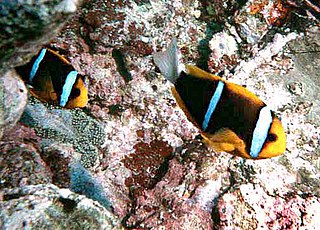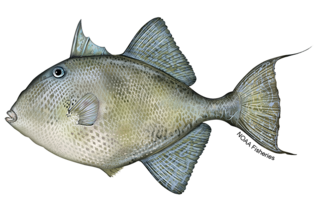
The orange-fin anemonefish is a marine fish belonging to the family Pomacentridae, the clownfishes and damselfishes, found in the Western Pacific north of the Great Barrier Reef from the surface to 20 m, to include the Pacific Ocean between Queensland, Australia, and New Guinea to the Marshall and Tuamotus Islands. It can grow to 17 cm in length.

Allard's clownfish or Allard's anemonefish is a marine fish belonging to the family Pomacentridae, the clownfishes and damselfishes, from the western Indian Ocean off the coast of East Africa and the Mascarenes.

The grey triggerfish, or gray triggerfish, is a species of ray-finned fish in the triggerfish family. The species is native to shallow parts of the western Atlantic from Nova Scotia to Argentina and also the eastern Atlantic, the Mediterranean Sea and off Angola on the west coast of Africa.

The butterfly blenny is a small marine blenniid fish of Northern and Western Europe, as well as the Mediterranean Sea and Black Sea and Morocco. It is usually found at a depth of 10–400 metres (33–1,312 ft) down, especially in areas with a rocky floor.

Pterois antennata, the spotfin lionfish, banded lionfish, broadbarred lionfish, broadbarred firefish, raggedfinned firefish, raggedfinned scorpionfish or roughscaled lionfish, is a species of marine ray-finned fish belonging to the family Scorpaenidae, the scorpionfishes and lionfishes. It is found in the tropical Indian and Western Pacific Oceans.

Dendrochirus brachypterus, the dwarf lionfish, short-finned turkeyfish, shortspine rockcod or shortspine scorpionfish, is a species of marine ray-finned fish belonging to the family Scorpaenidae, the scorpionfishes and lionfishes. It is found in the Indo-Pacific. It is sometimes found in the aquarium trade.

The Australian blenny is a small marine blennioid fish of the genus Ecsenius. They are small and reddish brown with a white ventral side. Australian blennies inhabit the shallow marine waters of the tropics. They are often found along the Great Barrier Reef and Coral Sea of Australia.

Montagu's blenny, also known as the capuchin blenny, is a species of combtooth blenny found in the intertidal zones of the eastern Atlantic ocean from England to Madeira and the Canary Islands as well the Mediterranean Sea, the Black Sea and the Sea of Marmara. This species prefers rocky shores with much wave action. This species grows to a length of 7.6 centimetres (3.0 in) SL. It is the only species in the genus Coryphoblennius.
Chasmodes saburrae, the Florida blenny, is a species of combtooth blenny found in the western central Atlantic Ocean, around the coast of the United States.

Bellator egretta, the streamer searobin, is a species of marine ray-finned fish belonging to the family Triglidae, the sea robins. This fish is found in the western Atlantic Ocean.

Istiblennius dussumieri, the streaky rockskipper, is a species of combtooth blenny found in coral reefs in the western Pacific and Indian Oceans. It is also commonly known as the Dussumier's rockskipper, streaky dussumier, or the Dussumier's blenny.

The seaweed blenny is a species of combtooth blenny found in coral reefs in the western Atlantic Ocean along the coasts of New York, Bermuda, the Bahamas, also in the Gulf of Mexico, south to southern Brazil. This species reaches a length of 8.5 centimetres (3.3 in) TL.

The Portuguese blenny, also known as the red blenny, is a species of combtooth blenny found in the eastern Atlantic ocean off western Europe and Macaronesia.
Clinoporus biporosus, the ladder klipfish, is a species of clinid found in subtropical waters of the Atlantic Ocean around the South African coast. It occurs in the subtidal zone down to a depth of 30 metres (98 ft). This species can reach a maximum length of 13 centimetres (5.1 in) TL. It is currently the only known member of the genus Clinoporus.
Gobioclinus gobio is a strictly marine ray finned fish, also called Gobioclinus gobio. Its common name is the palehead blenny, and is sometimes referred to as the goggle-eye blenny. It can be identified by its greenish top, red belly, and multicolored banding. L. gobio is a benthic organism with a wide range, taking up residence in a number of coastal environments from Florida to Brazil. This means the fish can live in equatorial, subtropical, and tropical climatic zones. It is native to coastal areas of the Caribbean. Its diet consists mainly of different molluscs and echinoderms.

Stegastes pictus, the yellowtip damselfish, is a species of damselfish found near the sea bed on shallow rocky reefs off the coast of Brazil, where it is endemic. It is a small, laterally-compressed, dark brown fish with yellow pectoral and caudal fins. It feeds on algae and detritus and is often found in the vicinity of the fire coral Millepora alcicornis. It is a territorial fish and forms a pair bond in the breeding season. The eggs are laid in a shallow scoop on the seabed and the male tends them to keep them well-aerated.

Myoxocephalus scorpioides, the Arctic sculpin or northern sculpin, is a species of marine ray-finned fish belonging to the family Cottidae, the typical sculpins. This fish is found in the Arctic Ocean.

Parapercis hexophtalma, the speckled sandperch, is a species of marine bony fish in the family Pinguipedidae, found in the western Indo-Pacific Ocean. It was first described by the French naturalist Georges Cuvier in 1829. There are several synonyms, some of which represent misspellings of the original name, and others which were given to female fish, at the time thought to be a separate species.
The pearl blenny is a species of combtooth blenny from the subfamily Salarinae of the family Blenniidae. It occurs in shallow coastal waters in the western Atlantic Ocean. It is the type species of the genus Entomacrodus.

The saddleback gunnel, also known as the saddled blenny, is a species of marine ray-finned fish belonging to the family Pholidae, the gunnels. This fish occurs in the shallow coastal waters of the eastern North Pacific Ocean.



















